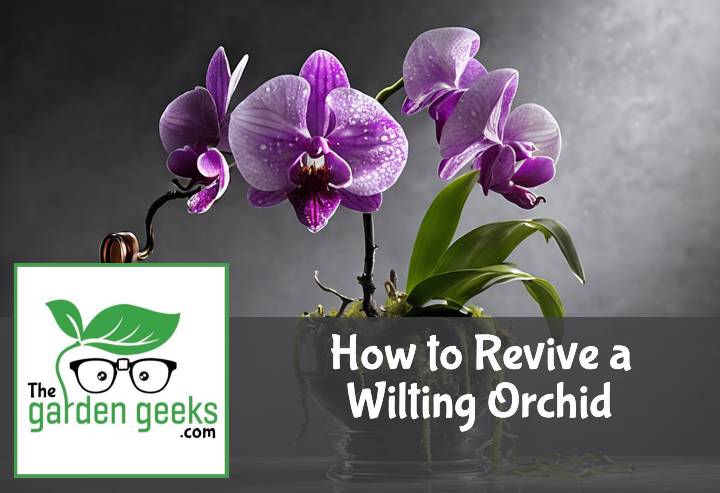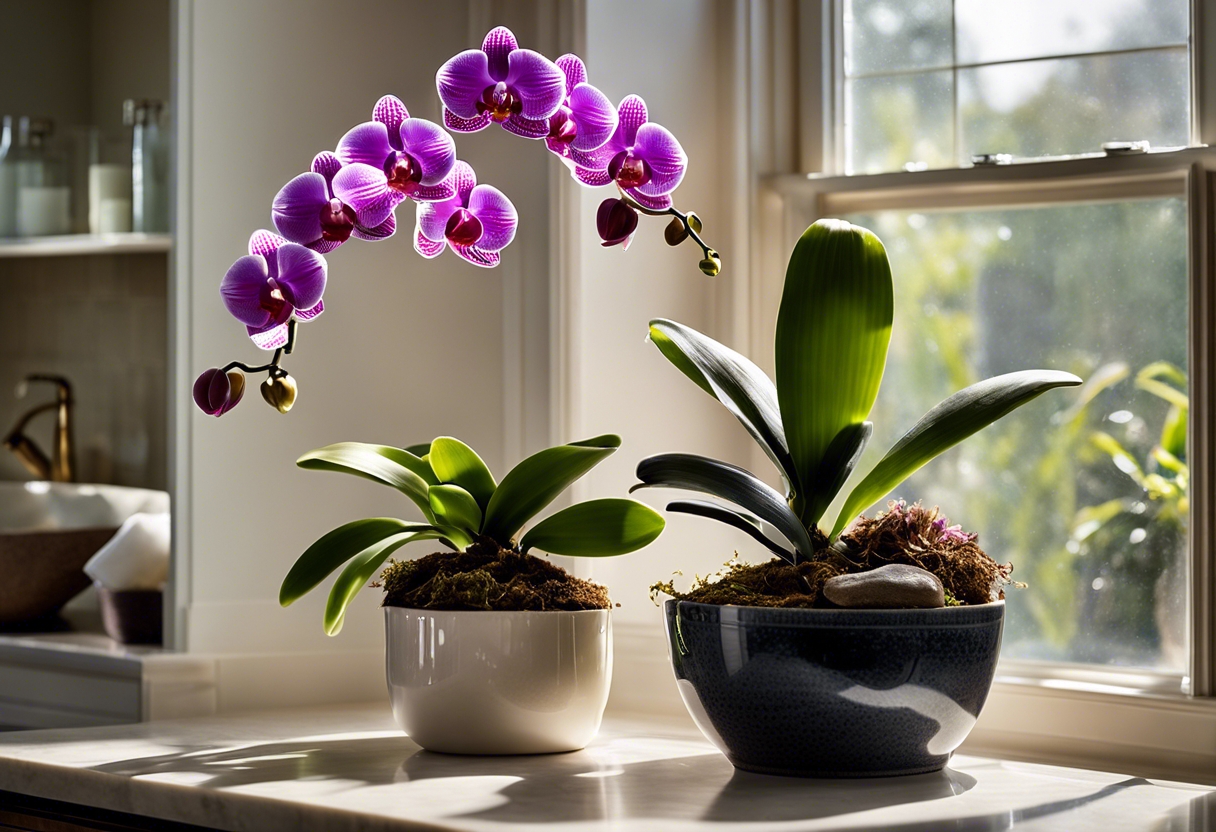Ever found yourself staring at your once vibrant and lively orchid, now wilting and looking a little worse for wear? Yeah, me too. It’s like watching a piece of your green-thumb street cred wither away. But don’t despair! I’m here to guide you on How to Revive a Wilting Orchid.
Orchids can be fickle, yes, but with the right care and attention (and maybe a bit of plant whispering), they’ll bounce back in no time. So buckle up, fellow plant enthusiasts, we’re about to bring your orchid back from the brink! Keep reading about How to Revive a Wilting Orchid.
Key Takeaways
- Identify the problem: Overwatering, underwatering, temperature stress or insufficient light can cause wilting.
- Adjust watering: Orchids should be watered once a week in winter and twice a week in summer.
- Modify light and temperature: Orchids need indirect sunlight and temperatures between 60-75°F.
- Repot if necessary: If roots are rotten, repot the orchid using fresh orchid mix.
- Use a humidity tray or humidifier to increase humidity levels around the plant.
Understanding Orchid Health
Orchid health is a crucial aspect of orchid care. It’s like being a plant doctor, you need to recognize the signs of wilting and understand the common causes. This knowledge helps in maintaining healthy orchids and preventing orchid diseases.
Recognizing Signs of a Wilting Orchid
So, how do you spot a wilting orchid? Well, it’s all about knowing the wilting orchid symptoms. If your orchid starts looking like it’s having a bad hair day with drooping leaves, that’s one sign.
Another telltale symptom is if its flowers start yellowing like they’ve been out in the sun too long without sunscreen. These are clear signs of plant distress and key indicators for identifying unhealthy orchids.
Common Causes of Orchid Wilting
Now let’s talk about why your orchid might be wilting. One common cause is overwatering your orchids – yes, plants can drown too! Another reason could be insufficient light for orchids – they’re not vampires; they need their sunlight!
Incorrect temperature for orchids can also lead to wilting; they’re not fans of extreme weather conditions. Poor soil quality is another culprit – think of it as feeding your orchids junk food instead of healthy meals.
Lastly, root rot in orchids is like the flu for us humans – it can really knock them down. So remember, understanding these causes is essential on how to revive a wilting orchid!
Assessing Your Orchid’s Environment
When it comes to how to revive a wilting orchid, the first step is understanding your orchid care environment. You see, these beauties are a bit fussy and need just the right conditions to thrive.
Evaluating Light Conditions
Let’s start with light. Orchids love light, but not too much of it. So, how do you know if your orchid is getting enough? Well, look at its leaves. If they’re a healthy green color, you’re good. But if they’re dark green, your orchid might be throwing shade… literally! It could use more light.
On the other hand, if the leaves are yellow or have red spots, that’s like your orchid saying “Whoa there! Too much sun!” That’s when you know it’s time to move your plant somewhere less bright.
Checking Temperature and Humidity Levels
Next up: temperature and humidity. Orchids aren’t fans of extreme temperatures – they prefer things just right in the middle. A good orchid temperature range is between 60 and 80 degrees Fahrenheit.
Humidity-wise, think tropical rainforest vibes – about 40-70%. You can achieve this by placing a tray of water near your plant or using a humidifier.
Reviewing Potting Medium and Container
Finally, let’s talk dirt…or rather potting medium because orchids don’t actually grow in regular soil! They prefer something lighter like bark or sphagnum moss which allows their roots to breathe.
And speaking of breathing roots, make sure your container has plenty of drainage holes. Orchids hate having wet feet! So remember folks: when it comes to orchid potting medium and containers – think airy and well-draining!
Reviving Your Wilting Orchid: Immediate Actions
Hey there, plant parent! Got a wilting orchid on your hands? Don’t fret. We’re here to help you with some Immediate Orchid Help. It’s time to roll up your sleeves and get into the nitty-gritty of Wilting Orchid Care.
Adjusting Watering Techniques
First things first, let’s talk about watering. If you’re wondering How to Revive a Wilting Orchid, adjusting your watering techniques is key. Overwatering or underwatering can be harmful for these delicate beauties.
You see, orchids aren’t too fond of wet feet. They like their roots airy and dry. So if you’ve been giving them a daily soak, that might be the culprit behind your wilting woes. On the flip side, underwatering isn’t great either.
Your best bet? Aim for moist but not waterlogged soil – that’s the sweet spot for Hydration for Wilting Orchids.
Changing the Location or Light Exposure
Next up on our Orchid Rescue Tips, we’re talking light exposure and location change. Too much sunlight can cause sunburn (yes, plants get sunburnt too!), while too little can lead to weak growth and poor blooming.
So where should you place your orchids? Well, east-facing windows are usually a safe bet for these light-loving plants. But remember, every home is different so experiment with different spots until you find one that works.
And if all else fails, don’t be afraid to move them around! Sometimes a simple change in scenery is all it takes to bring an orchid back from the brink.
Modifying Temperature and Humidity
Last but definitely not least on our list of immediate actions is tweaking temperature and humidity levels – crucial factors in any Orchid Rescue Tips guide.
Orchids are tropical plants, which means they love warm temperatures and high humidity. But too much heat or cold can stress them out, leading to wilting.
So how do you strike the right balance? Aim for a temperature range of 65-75 degrees Fahrenheit during the day and a drop of about 10 degrees at night. As for humidity, aim for around 50-70%.
And there you have it! With these tips in your plant-care arsenal, you’re well on your way to reviving your wilting orchid. Good luck!
Long-Term Care Strategies for Healthy Orchids
Long-term care strategies are the secret sauce to maintaining healthy orchids. It’s all about choosing the right fertilizer, knowing when to repot, and keeping a keen eye on your plant.
Choosing the Right Fertilizer for Your Orchid
Picking the right grub for your green buddy is crucial. The orchid fertilizer selection process isn’t rocket science, but it does require some thought.
The best fertilizers for orchids have a balanced mix of nutrients. They’re like a gourmet meal for your plant! This helps in promoting orchid growth and keeps them blooming beautifully.
Repotting Your Orchid When Necessary
Repotting? Sounds scary, doesn’t it? But trust me, it’s not as terrifying as it sounds. In fact, repotting orchids can be quite beneficial.
Knowing when to repot orchids is key. If you see roots creeping out or if the plant looks too big for its boots – that’s your cue! The benefits of repotting include giving your plant more room to grow and improving its overall health.
Regular Monitoring and Maintenance
Just like us humans, plants need regular check-ups too! Monitoring orchids regularly helps you spot any issues early on.
Maintaining healthy orchids over time requires consistent care. Think of it as a spa day for your plant – only this spa day happens regularly!
Remember folks, learning how to revive a wilting orchid starts with prevention. So keep these tips in mind and give your green friends the love they deserve!
Troubleshooting Persistent Problems
Orchid lovers, we’ve all been there. You’re doing your best to keep your orchid happy and then bam! It starts wilting. But don’t worry, how to revive a wilting orchid isn’t as hard as it seems. Let’s dive into some common orchid care problems like pests, diseases, and the dreaded root rot.
Dealing with Pests and Diseases
Orchids can be a bit of drama queens sometimes. They’re prone to a few common orchid diseases and pesky pests that can cause them to wilt. If you notice any weird spots or creepy crawlies on your plant, it’s time for some orchid pests treatment.
But hold up! Don’t just grab any old pesticide off the shelf. You gotta be careful not to harm your delicate flower further while treating diseased orchids. So always opt for safe pest control for orchids, okay?
And remember, prevention is better than cure! Keeping an eye out for early signs of trouble can help in preventing orchid disease before it gets too serious.
Addressing Root Rot in Orchids
Now let’s talk about something that gives every plant parent nightmares – root rot! This nasty condition is one of those persistent orchid issues that can really mess with your plant’s health.
Root rot is basically when the roots of your plant start decaying due to overwatering or poor drainage. The symptoms? Your orchid might start looking a bit droopy or its leaves may turn yellow.
So how do you deal with this? Start by trimming away the rotten parts and then repotting your orchid in fresh soil. And remember folks, prevention is key here too! Avoid overwatering and ensure good drainage to prevent this issue from recurring.
There you have it, a quick guide on troubleshooting orchid diseases and dealing with root rot. With these tips, you’ll be well on your way to reviving your wilting orchid in no time!
To Wrap Up
Just like a toddler needs love and care, your wilting orchid craves attention too. We’ve dished out the lowdown on How to Revive a Wilting Orchid.
So go on, channel your inner green-thumb and bring that beauty back to life!





